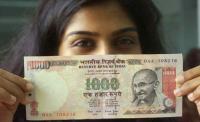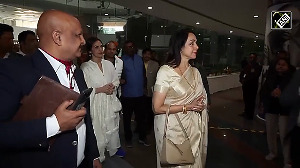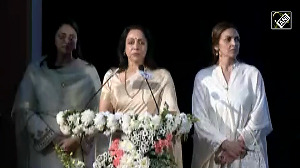This article was first published 13 years ago
Mystery of the falling rupee
Share:
January 04, 2012 10:48 IST
 I
Is something strange afoot in the rupee-dollar market, or am I just imagining things? The rupee continues to remain under pressure and apparently there is fairly heavy intervention by the Reserve Bank of India to stop it slipping past 54 to the dollar again.
Yet, if you ask any trader in a bank treasury, he is likely to tell you that there is hardly any shortage of dollars in the markets.
Thus, the momentum of the rupee doesn't seem to be driven by a large mismatch between the supply and demand for dollars. The only way to explain its frailty is to attribute it to weak sentiment, which keeps it offered.
One clear indication of this is the way forward premiums have behaved. As anyone who has taken a basic course in international economics would know, forward premiums reflect the difference in interest rates across economies whose currencies are involved.
Thus, the forward premium for the rupee is the difference between rupee interest rates and dollar interest rates - relevant, of course, to the tenure for which the premium is calculated.
One way to interpret a forward premium is as a gauge of the relative availability of rupees vis-a-vis dollars.
If rupees are abundant and dollars are in short supply, then rupee interest rates are likely to be low and dollar rates high, pulling forwards down.
In the extreme case, when there is a famine of dollars, forwards go into discount as traders seeking dollars offer the sky in terms of dollar interest rates relative to rupee interest rates.
In fact, our analysis of episodes of sharp depreciation since 2004 shows that they were preceded by periods of discount.
Yet, strangely enough, the current episode of depreciation that took the rupee to an unprecedented low was not preceded by a period of forward discounts.
Right through the period, forwards have kept rising. This would imply (if you are comfortable with my interpretation of forward rates) that the depreciation has taken place when rupee liquidity has actually been short relative to dollar liquidity - and not the other way round, as, theoretically, should have happened.
The other way to look at this conundrum is to try and map the relationship between dollar flows and the exchange rate and check whether the exchange rate is in line, or completely out of whack, with the balance of flows.
To do this, you could use the balance of payments deficit or surplus (published quarterly) and link it, as we did at HDFC Bank, to the rupee-dollar exchange rate through a formal statistical model.
The BoP is incidentally a summary of the inflows and outflows of dollars into the system for a period and the final balance reflects the
excess demand or supply of dollars.
Here's what we found. To start with, even if we were to assume extremely aggressive outflows, we get a deficit of roughly $22 billion over 2011-12. (The April-September period for which hard data is available, incidentally, yielded a small surplus).
The second step we took was to assume that this deficit is concentrated in the period between the end of September and December, that is, the period over which the depreciation pressure was most acute.
Our model, which is based on a long-term relationship between the BoP and the rupee-dollar exchange rate, predicts an exchange rate of 49.40.
In short, a range of 49-50 appears to be the "equilibrium" exchange rate of the rupee.
Sceptics would argue that our entire prognosis rests on a somewhat flimsy assumption regarding the BoP position. To counter this, here's what we wrote in a recent report titled
INR: no more depreciation left?: "One possibility is that our BOP estimates are too conservative. The actual deficit, one could argue, is possibly much higher.
"There has been, as we know, a paucity of foreign currency credit and redemptions are high this year. That could be driving a gap that is higher than we predict. Similarly the current account deficit could be higher than $67 billion, or 3.3 per cent of GDP, that we are working with.
"Our argument is that while that is theoretically possible, it does not quite square up with the situation on the ground, where outflows seem to be matched by adequate inflows."
What's the bottom line then? For one thing, if you are using the demand-supply balance to "value" the exchange rate, then the rupee seems undervalued or oversold. The move beyond 50 to the dollar seems to be driven by adverse news-flow and sentiment, rather than a genuine excess demand for dollars.
Were that indeed the case, RBI's measures to curb speculation are likely to be effective.
Second, it is possible that like all other financial assets, the rupee is pricing in a future shortage of dollars - perhaps based on the fact that portfolio flows will be scanty next year.
We buy this argument, but argue that at a level of over Rs 3 above the fair value, a lot of the potential bad news is already priced in. Thus, even if fundamentals were to worsen, there might not be further depreciation.
If the rupee is indeed stuck in a fragile equilibrium, then any surge in inflows could lead to a quick turnaround in the rupee.
Non-resident deposit rates have been deregulated, and banks have jacked up the rates on these deposits.
If non-resident Indians respond to enormous arbitrage possibilities that this entails, a phase of quick appreciation might not be too far away.
The author is chief economist, HDFC Bank
 Is something strange afoot in the rupee-dollar market, or am I just imagining things? The rupee continues to remain under pressure and apparently there is fairly heavy intervention by the Reserve Bank of India to stop it slipping past 54 to the dollar again.
Is something strange afoot in the rupee-dollar market, or am I just imagining things? The rupee continues to remain under pressure and apparently there is fairly heavy intervention by the Reserve Bank of India to stop it slipping past 54 to the dollar again.










